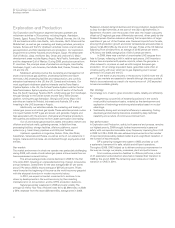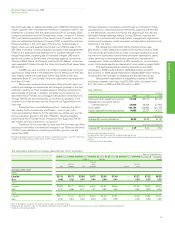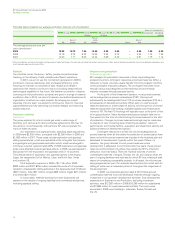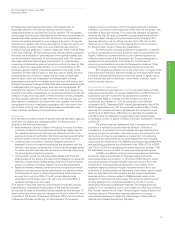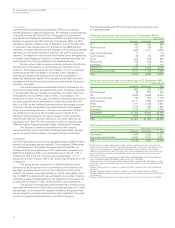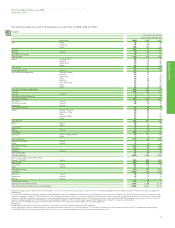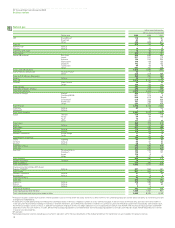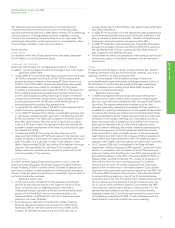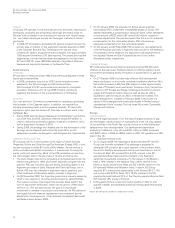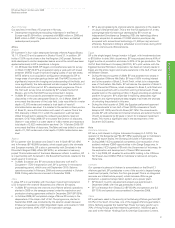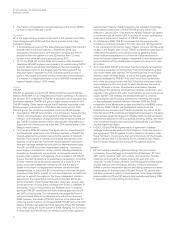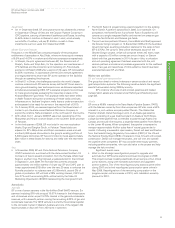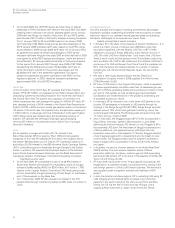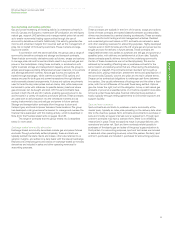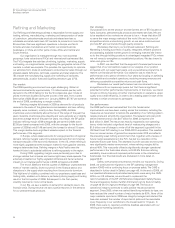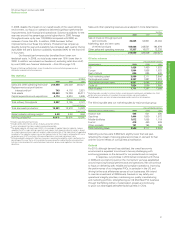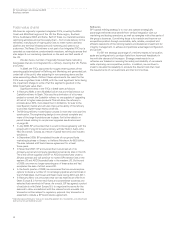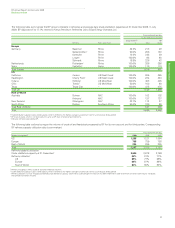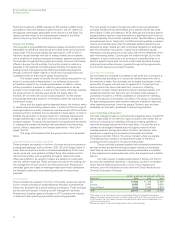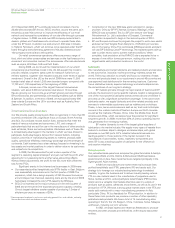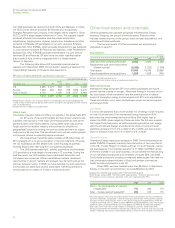BP 2009 Annual Report Download - page 34
Download and view the complete annual report
Please find page 34 of the 2009 BP annual report below. You can navigate through the pages in the report by either clicking on the pages listed below, or by using the keyword search tool below to find specific information within the annual report.
32
BP Annual Report and Accounts 2009
Business review
• The Platform A development project approved at the end of 2008 is
on track to deliver first gas in 2010.
Azerbaijan
BP is the largest foreign investor in the country. BP operates two PSAs,
Azeri-Chirag-Gunashli (ACG) and Shah Deniz, and also holds other
exploration leases.
• A comprehensive review of the subsurface gas release that occurred
beneath the Central Azeri platform in September 2008, and
subsequent remedial works, have resulted in bringing the level of
production from the platform to over 220mboe/d from 12 wells.
Further minor remedial work is planned during 2010.
• On 13 July 2009, BP and the State Oil Company of the Republic of
Azerbaijan (SOCAR) signed a memorandum of understanding (MOU)
to jointly explore and develop the Shafag and Asiman structures in
the Azerbaijan sector of the Caspian Sea. The MOU gives BP the
exclusive right to negotiate the PSA. The block covers an area of
some 1,100 square kilometres and has never been explored before.
It is located in a deepwater section of about 650-800 metres with
reservoir depth of about 7,000 metres.
Russia
TNK-BP
TNK-BP, an associate owned by BP (50%) and Alfa Group and Access-
Renova (AAR) (50%), is an integrated oil company operating in Russia and
the Ukraine. BP’s investment in TNK-BP is reported in the Exploration and
Production segment. The TNK-BP group’s major assets are held in OAO
TNK-BP Holding. Other assets include the BP-branded retail sites in the
Moscow region and interests in OAO Rusia Petroleum and the OAO
Slavneft group. The workforce comprises more than 52,000 people.
• Downstream, TNK-BP has interests in six refineries in Russia and the
Ukraine (including Ryazan and Lisichansk and Slavneft’s Yaroslavl
refinery), with throughput of approximately 683 thousand barrels per
day. TNK-BP supplies approximately 1,400 branded filling stations in
Russia and the Ukraine and has more than 20% market share of the
Moscow retail market.
• On 9 January 2009, BP reached final agreement on amendments to
the shareholder agreement with its Russian partners in TNK-BP. The
revised agreement is aimed at improving the balance of interests
between the company’s owners, and focusing the business more
explicitly on value growth. The former evenly balanced main board
structure has been replaced by one with four representatives each
from BP and AAR, plus three independent directors. Unanimous
board support is required for certain matters including substantial
acquisitions, divestments and contracts, and projects outside the
business plan, together with approval of key changes to the TNK-BP
group’s financial framework and related-party transactions. A number
of other matters will be decided by approval of a majority of the
board, so that the independent directors will have the ability to
decide in the event of disagreement between the shareholder
representatives on the board. BP will continue to nominate the chief
executive officer (CEO), subject to main board approval, and AAR will
continue to appoint the chairman. The three independent directors
appointed to the restructured main board are Gerhard Schroeder,
former chancellor of the Federal Republic of Germany, James Leng,
former chairman of Corus Steel and Alexander Shokhin, president of
the Russian Union of Industrialists and Entrepreneurs. In addition,
significant TNK-BP subsidiaries will have directors appointed by BP
and AAR on their boards. Our investment was reclassified from a
jointly controlled entity to an associate with effect from 9 January
2009; however, the results of TNK-BP continue to be accounted for
under the equity method. On 6 August 2009, TNK-BP announced that
William Schrader was appointed chief operating officer. Mr. Schrader
took office during the fourth quarter of 2009, replacing Tim Summers.
In November, the TNK-BP board of directors unanimously agreed to
appoint Maxim Barsky, TNK-BP executive vice president for strategy
and business development, as the TNK-BP group’s future CEO,
effective 1 January 2011. Until that time, Mikhail Fridman has agreed
to continue to act as interim CEO, in addition to his role as executive
chairman of the board of directors of TNK-BP Limited.
• On 16 February 2009, TNK-BP announced that the company had
launched commercial production from the Urna and Ust-Tegus fields
in the Uvat area of the Tyumen region, Russia. Urna and Ust-Tegus are
located in the eastern part of Uvat. TNK-BP completed construction of
a 264-kilometre pipeline and a central crude oil gathering facility,
which facilitate transportation of oil from the fields westwards to
enter the Transneft pipeline system. Investment in field development
and construction of the infrastructure is expected to amount to over
$1.5 billion.
• On 2 June 2009, TNK-BP announced that the company had launched
commercial production in the Northern Hub of the Kamennoye field,
one month earlier than planned. The Kamennoye field, in the Khanty-
Mansiisk region of West Siberia, is one of the largest greenfield
projects developed by TNK-BP. Aitor and Poima form the Northern
Hub of the producing Kamennoye field. Thirty-five wells were drilled
and completed in Aitor and, going forward, the primary focus is on
drilling 194 wells in Poima. Infrastructure construction includes
upgrading of the gathering and treatment facilities, construction and
upgrade of the pipeline and water flood systems as well as the power
supply system. This strategy and development plan is aimed at
maximizing the use of existing facilities and minimizing the impact
on the ecologically sensitive territory. Between 2004 and 2009,
investment in the Kamennoye project amounted to over $800 million.
• On 29 July 2009, TNK-BP and Weatherford International Ltd
(Weatherford) announced that TNK-BP completed the sale of its Oil
Field Services (OFS) enterprises to Weatherford pursuant to the sales
and purchase agreement signed on 29 May 2009. Via this transaction,
Weatherford acquired 10 OFS companies providing drilling, well work-
over and cementing services operating in West Siberia, East Siberia
and the Volga-Urals region.
• In 2007, BP and TNK-BP signed heads of agreement to create
strategic business alliances with OAO Gazprom. Under the terms of
this agreement, TNK-BP agreed to sell to Gazprom its stake in OAO
Rusia Petroleum, the company that owns the licence for the Kovykta
gas condensate field in East Siberia and its interest in East Siberia
Gas Company. Discussions to conclude this disposal continue.
Sakhalin
• BP has material interests in Sakhalin through two joint venture
companies, Elvary Neftegaz and Vostok Shmidt Neftegaz. BP has a
49% equity interest in each joint venture, and its partner, Rosneft,
holds the remaining 51% interest. During the year, both joint
ventures, via their Russian affiliates, held Geological and Geophysical
Studies licences with the Russian Ministry of Natural Resources
(MNR) to perform exploration seismic and drilling operations in these
licence areas off the east coast of Russia. To date, 3D seismic data
has been acquired in relation to both licences. In the Elvary Neftegaz
licence additional 2D and 3D seismic data was acquired during 2009
in preparation for future drilling commitments.


